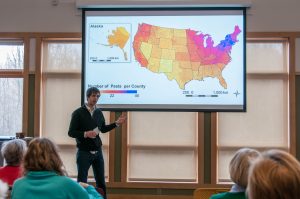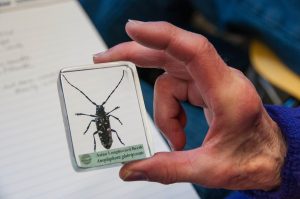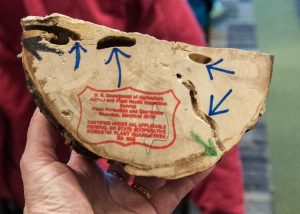People have a special relationship with trees. They evoke memories of picnics on summer days, children swinging from their branches or watching fledglings take the first flight from a favorite perch. Unlike many of our native plants, when trees die, people take notice. Perhaps that’s why the RCWO’s March meeting drew a good crowd to Calvin’s Bunker Interpretive Center. We all wanted to know how to save our trees!

We were in capable hands with three certified arborists. Lee Mueller of Davey Resource Group’s Natural Resource Consulting team began by giving the group an overview of tree diseases. He discussed the American Chestnut blight which decimated 3-4 BILLION trees in the early part of the 20th century. The loss of these magnificent trees, some nearly as large as the iconic redwood, irreparably altered the ecosystems of the great northeastern forests. Although some have grown back from stumps, the most prevalent hardwood of its day is now functionally removed from the ecosystem. This was our first brush with foreign invaders and a very tough lesson ?to learn.
In 1928 the Dutch Elm Disease burst on the scene, caused by a tiny beetle which spreads the fungus. An estimated 75% of the 77 million trees fell prey to this tiny invader. Ash trees replaced the gaping hole left by the elms, only to be devastated by the now-familiar Emerald Ash Borer. Hemlocks are under attack too from the an innocuous looking little invader called the Woolly Adelgid, who forms white, fuzzy balls on the needles essentially isolating the pest from pesticides.
On this happy note, Lee introduced Bill Brown, an urban forester with ArborPro who is trained in tree risk assessment. Bill primarily discussed the dreaded Asian Long-horned Beetle, which is believed to have come to North America in packing material. It is particularly menacing because it attacks many tree species. Experts believe that thirteen different genera are in danger from this wood-boring pest, all of which are present in Michigan. New York City, Worcester, MA and Bethel, OH have active infestations. Three other infestation areas – Chicago, New Jersey and Toronto – have been irradicated. There is currently no known infestation in Michigan, but we must remain vigilant if we hope to save our trees. Some signs to watch for include nickel-sized egg sites on tree bark, exit holes that come straight out from the tree and “frass”, which is wood shavings from the borings, that looks like matchsticks. If you see a suspect tree or beetle, take photos, record the location, collect any suspect beetles in a jar?and report it to [email protected] or call 1-800-292-3939.


Vic Foerster, a consulting arborist with West Michigan Tree Services and author of a wonderful book about Isle Royale called Naked in the Stream,?closed the program with a sobering talk on Oak Wilt. It is similar to Dutch Elm Disease in that it is fungal. Red and black oaks are more susceptible than white oaks, but all can be attacked. The decline happens quickly. A healthy tree attacked in May can lose all leaves and be dead by July. Oak Wilt is a vascular disease, so it is nearly impossible to know of the infestation until it’s too late. It is most readily spread through root grafts, but can also spread from bark beetles that pick up the fungus from pressure pads that form under the trunk. These beetles are highly attracted to fresh pruning cuts during the growing season. Vic cautioned us not to prune until fall. If pruning cannot be avoided due to something like storm damage, he said to make a fresh cut and paint it with pruning paint or latex paint.
While the topic was a dismal one, there was cause for optimism. We have people like our three guests looking out for these unwelcome pests and educating the public. There are no infestations of ALB (Asian Long-horned Beetle) in Michigan yet. Infestations can be controlled, although that usually means the removal of many suspect trees. We were left with a few dos and don’ts to remember.
- Never Move Firewood!
- Don’t Prune Trees During the Growing Season!
- Report Suspected Infestations Immediately!
The evening ended on a pleasant note. Our guests stayed to answer questions and Vic brought along some of his books to sell giving half of the proceeds to RCWO! Thanks to all involved for another great program.
